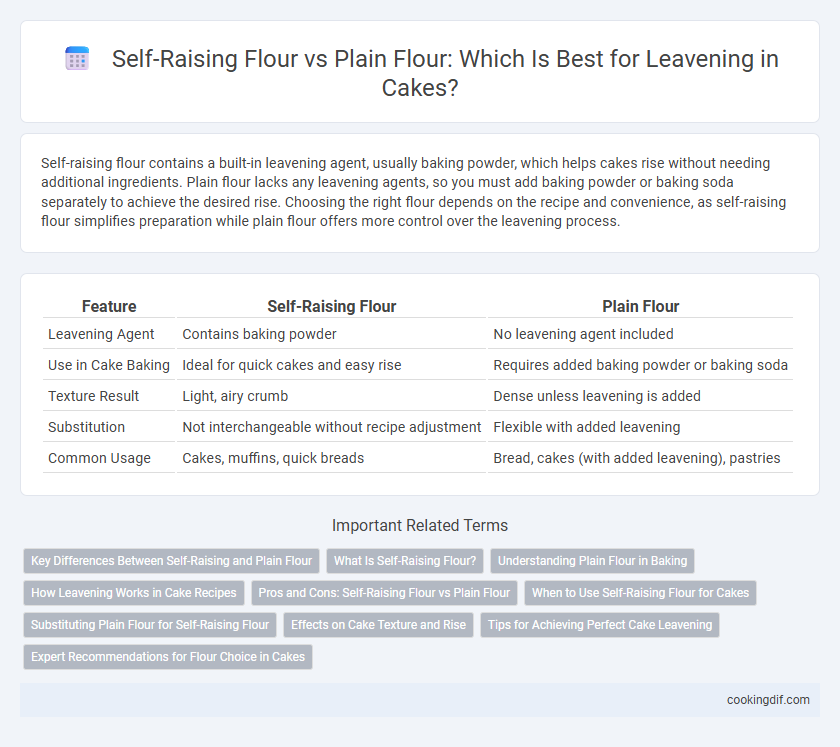Self-raising flour contains a built-in leavening agent, usually baking powder, which helps cakes rise without needing additional ingredients. Plain flour lacks any leavening agents, so you must add baking powder or baking soda separately to achieve the desired rise. Choosing the right flour depends on the recipe and convenience, as self-raising flour simplifies preparation while plain flour offers more control over the leavening process.
Table of Comparison
| Feature | Self-Raising Flour | Plain Flour |
|---|---|---|
| Leavening Agent | Contains baking powder | No leavening agent included |
| Use in Cake Baking | Ideal for quick cakes and easy rise | Requires added baking powder or baking soda |
| Texture Result | Light, airy crumb | Dense unless leavening is added |
| Substitution | Not interchangeable without recipe adjustment | Flexible with added leavening |
| Common Usage | Cakes, muffins, quick breads | Bread, cakes (with added leavening), pastries |
Key Differences Between Self-Raising and Plain Flour
Self-raising flour contains a pre-mixed leavening agent, typically baking powder, which allows cakes to rise without additional ingredients. Plain flour lacks any leavening agents, requiring separate baking powder or soda to achieve the desired rise. Using self-raising flour simplifies recipes and ensures consistent texture, while plain flour offers more control over leavening quantities and is versatile for various baking needs.
What Is Self-Raising Flour?
Self-raising flour is plain wheat flour pre-mixed with a specific amount of leavening agents, typically baking powder, to help cakes rise without additional raising agents. This flour simplifies baking by evenly distributing the leavening throughout the mixture, ensuring consistent texture and lift in cakes. Using self-raising flour eliminates the need for separate baking powder measurements, making it a convenient choice for quick and reliable cake recipes.
Understanding Plain Flour in Baking
Plain flour, also known as all-purpose flour, contains minimal to no leavening agents, making it a versatile base ingredient in baking that requires the addition of external leavening agents like baking powder or baking soda for rise. It provides a neutral texture and flavor, ideal for recipes where precise control over leavening and texture is needed. Understanding plain flour's role allows bakers to customize the rise and crumb structure by adjusting leavening agents, resulting in cakes with targeted lightness and moisture.
How Leavening Works in Cake Recipes
Self-raising flour contains a built-in leavening agent, typically baking powder, which releases carbon dioxide when mixed with wet ingredients, causing the cake batter to rise and create a light, airy texture. Plain flour lacks these leavening agents and requires the addition of baking powder or baking soda to achieve similar rising effects. Understanding the chemical reaction that produces gas bubbles is crucial for proper cake structure and crumb development.
Pros and Cons: Self-Raising Flour vs Plain Flour
Self-raising flour contains added baking powder and salt, providing consistent leavening and convenience for quick cakes, but it limits control over rising agents. Plain flour offers versatility, allowing bakers to customize leavening intensity by adding baking powder or baking soda as needed, ideal for precise texture and flavor adjustments. However, plain flour requires accurate measurement and knowledge of leavening ratios to avoid dense or overly risen cakes.
When to Use Self-Raising Flour for Cakes
Self-raising flour contains a pre-mixed combination of plain flour and leavening agents like baking powder, making it ideal for quick and easy cake recipes that require consistent rising without additional leaveners. Use self-raising flour when baking sponge cakes, cupcakes, or other light, airy cakes where a uniform rise and fine crumb texture are desired. Avoid self-raising flour if the recipe calls for specific leavening control or when using heavy ingredients that might alter the rise.
Substituting Plain Flour for Self-Raising Flour
Substituting plain flour for self-raising flour requires adding a leavening agent to ensure proper cake rise, typically 1 to 1.5 teaspoons of baking powder per cup of plain flour. Without this adjustment, cakes made with plain flour tend to be denser and less fluffy compared to those made with self-raising flour, which already contains leavening powders. Precise measurement of baking powder is essential to maintain the intended texture and volume in baked cakes.
Effects on Cake Texture and Rise
Self-raising flour contains baking powder, which acts as a leavening agent to produce a lighter and airier cake texture with a noticeable rise. Plain flour lacks leavening agents, requiring added baking powder or baking soda to achieve similar results, affecting the cake's crumb and density if not measured accurately. The choice between these flours directly impacts the cake's fluffiness, volume, and overall mouthfeel.
Tips for Achieving Perfect Cake Leavening
Use self-raising flour for consistent leavening as it contains pre-mixed baking powder, simplifying ingredient measurements. When using plain flour, add a precise amount of baking powder--typically 1 to 1.5 teaspoons per cup--to ensure proper rise. Sift the flour and leavening agents together to evenly distribute and promote a light, airy cake texture.
Expert Recommendations for Flour Choice in Cakes
Expert bakers recommend using self-raising flour for cakes that require a light, airy texture due to its built-in leavening agents like baking powder. Plain flour, lacking these agents, is preferred when recipes call for precise control over rising by adding measured amounts of baking powder or baking soda separately. Choosing the appropriate flour depends on the desired crumb structure and leavening balance to achieve optimal cake volume and softness.
Self-raising flour vs Plain flour for leavening Infographic

 cookingdif.com
cookingdif.com